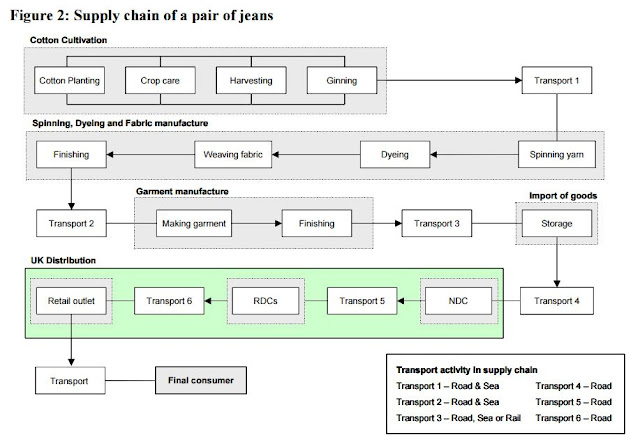Do you know the amount of energy used to create your pair of jeans?
As part of the Fashion Designers Do Good series, we look at how designer choices can influence energy consumption.
Energy Consumption Along the Supply Chain
There are a lot of points along the supply chain where we can make a difference, ranging from the fabric choice to the factory where we choose to manufacture the garments.
Let's look at a pair of jeans....
 |
| Source: Energy Consumption in the UK Jeans Supply Chain University of Westminister |
The University of Westminster conducted a Life Cycle Analysis of a pair of jeans manufactured for and distributed in the UK. This study was based on cotton jeans, but I'm sure the energy consumption would rise if the jeans were a blend of cotton and polyester or other synthetic material.
" product manufacture is the most energy intensive procedure in the jeans
supply chain studied (approximately 60% of total energy use in the supply chain), followed by cotton
fibre production (20%) and finished product stockholding and retailing (i.e. the energy used to run the
warehouses and shops in which jeans are stored and displayed) which is responsible for 18% of
energy use. The transport activities (i.e. commercial freight transport from field to shop, and
consumer transport to home) can be seen to account for 3% of the total energy used per kg of jeans
supplied."
Reducing Manufacture Energy Consumption
The manufacture process is so mechanised that it is hard to produce textiles without energy. I read (I can't remember where, sorry) that to reduce energy consumption at the cotton fibre production stage, it would be best to leave out the machinery and allow manual labour to take over. Personally I feel that would be a painstakingly slow and unhealthy process.
The Natural Resources Defense Council, suggests best practises to monitor and reduce energy consumption in textile mills. These include insulating pipes, heat recovery and optimising compressed air systems.

Image: Hazel Harper
Reducing Transport Energy Consumption
Want to transport your goods by air? Think again. The Natural Resources Defense Council, suggests:
Want to transport your goods by air? Think again. The Natural Resources Defense Council, suggests:
- Avoiding air transport whenever possible - Continental Clothing reduced greenhouse gas-emissions by 90 percent by switching to ocean-going ships for some of their products. French shoe line, Veja, also ships their products by freight from Brazil.
- Picking the type of ship wisely - Look for Grade A ships. According to shippingefficiency.org, choose a more fuel-efficient ship to potentially reduce carbon-dioxide emissions by up to 53 percent. Shippingefficiency is a database of ship rankings maintained by the nonprofit organization Carbon War Room.
- Considering the shipping route - OOCL has a carbon calculator for its shipping routes, while for trucking there is the option of joining the Voluntary Interindustry Commerce Solutions Association Empty Miles program. It is a collaborative network that enables businesses to reduce empty miles. This means trucks are not empty on the return leg of a journey.
 Image: Karen Winton
Image: Karen WintonEducating the Consumer
Levi Strauss looked at not only these stages of the jeans' lifecycle but at the consumer stages as well.
Levis Strauss realised that a little marketing muscle was needed to educate consumers on laundering in a more environmentally friendly manner.
How will you reduce your energy impact?





















My head is spinning. Do I or don't I buy jeans?
ReplyDeleteYou can still buy jeans, but just be in the know about how much resources went into them .... so you don't buy so many pairs!
DeleteIt's a good question KC. We need to wear clothes and long lasting jeans (as opposed to fashion jeans) are a good option. I guess we need to pay attention to who we buy from and that they are paying attention to their own production wastefulness, but where we can easily make a difference right now today is to wash our jeans in cold water, less often and line dry.
DeleteI've never really thought about where my clothing ACTUALLY comes from. This is a lot of information. Bravo for putting it all together like this.
ReplyDeleteVery interesting, Agy! I must admit that I thought that by air was a better way to transport goods.
ReplyDeleteI am slowing becoming more and more aware of the impact of my small contribution to the environment. There is always something we can do to make it happen.
Thank you really very much for this informative post.